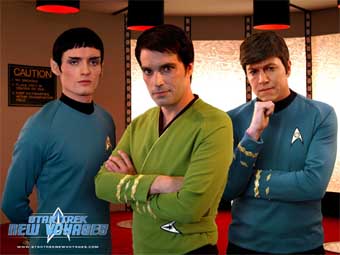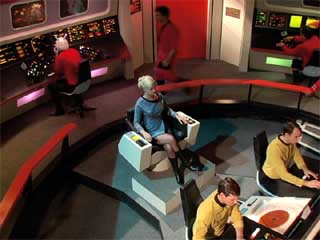pop up description layer
HOME
Cryptozoology UFO Mysteries Aviation Space & Time Dinosaurs Geology Archaeology Exploration 7 Wonders Surprising Science Troubled History Library Laboratory Attic Theater Store Index/Site Map Cyclorama
Search the Site: |
|
Notes from the Curator's Office: Home Movies
(5/07) There was a time when home movies meant an eight millimeter black and white film of your kids playing in the sand down by the beach. These were the dark ages of amateur filmmaking. Grainy, jumpy, moving pictures as far from a real cinematic experience as the Wright Brothers first glider was from the space shuttle. In the last few decades, technology has been steadily closing the gap, however. The type of equipment that big studios could only have dreamed about thirty years ago is now available to any teenager with a PC on his desk. As a result, films made by small groups of amateurs, or even individuals, are starting to look more and more like Hollywood productions. Science fiction fans have embraced this technology more than any other group I can think of and have produced an endless variety of shorts, parodies and trailers on their favorite subjects. Why science fiction fans are so keen on this is not quite clear (Gilligan's Island fans aren't up on this kind of thing?), but clearly they have created some of the most interesting work out there. Troops Probably the first major fan film that I can think of that looked more like a professional production than a home movie was Troops. This was created by Kevin Rubio in 1997 as a parody of the reality TV show COPS set in the Star Wars universe. Storm troopers are interviewed as they go about their jobs terrorizing the residents of Luke Skywalker's home planet of Tatooine. It is a humorous story that fits neatly into cracks in A New Hope (the fourth Star Wars film). The production, though short at ten minutes, demonstrated what a small group of dedicated fans could do with a little money and a lot of technology. It was a turning point and inspired a lot of other people to get involved in making their own home movie productions. To take a look at it, check out: http://www.theforce.net/fanfilms/shortfilms/troops/. What followed after Troops was a torrent of fan films with Star Wars themes. Some are good, some not-so-good, some terrible. I won't go into a long list of the best or worse, but simply point you to a good place to catch up on all these: a fan site called The Force.Net (http://www.theforce.net/fanfilms/). Not all worthy home movies from that era turned out to be Star Wars fan films, however. Some were original efforts. Take 405, a three-minute film by Bruce Branit and Jeremy Hunt done in 2000. This short-action/comedy takes a look at what happens when a DC-9 is forced to land on a Los Angeles freeway. What is so amazing about the film is that even though the airliner is featured prominently in the movie, it really doesn't exist. It is totally a CG (Computer Graphics) effect created on a desk top computer. I won't spoil the story further for you, but just tell you to take a look at the film at http://www.405themovie.com. Trek Fan Video
Of course, if Star Wars fans are hardcore, Star Trek fans are rabid. As a Treker myself, I'm proud to say that we have not been left out of the home movie movement. There are numerous examples, but the one that caught my eye was Star Trek: New Voyages. James Cawley, a long time Treker, got together with Jack Marshall and in 2003 created this completely fan staffed series. Their goal was to fix a hole left in the time-space continuum caused by NBC when they cancelled the original series (abbreviated as TOS - The Original Series - to those in the know) in 1969. To that end they are now working on producing the "fourth season" as if it had never been cancelled (the shows even start with the 60's NBC peacock logo). They have two episodes and a pilot produced with another coming out this month, the next one filming this June and another in preproduction. New Voyages is clearly one of the most ambitious fan film efforts ever mounted. While many of the Star Wars parodies make use of parks and futuristic office campuses to stand in for the locations in the Star Wars universe, New Voyages, with interior shots of the Enterprise a necessity, has had more of a more difficult challenge. At a former car dealership in Port Henry, New York, Cawley has lovingly reconstructed much of the Enterprise sets - including the entire bridge - as they were seen in the original series. While early episodes do not come up to a professional standard, it is clear that Cawley (who plays the new Captain Kirk) and his crew are getting better with each effort. The operation is of such high quality that it has attacted a number of professionals who were somehow connected with the original series. These iinclude William Windom (who guest starred as Commodore Decker in one TOS episode), Walter Koenig (who played Chekov in TOS), George Takei (Sulu in TOS) and a host of other actors. D.C. Fontana, a writer with the original show has penned one episode and has agreed to do another. All are working for free. One area where New Voyages particularly shines is the special effects. A determined amateur today can use his home computer to generate better footage of the Enterprise in flight than a whole studio worth of professionals could in 1969. Though the use of the effects for New Voyages first epsiode, In Harms Way, were critized by some viewers (computer effects contributer Max Rem had a tendency to spin the Enterprise through unrealistic barrel rolls like it was an X-wing fighter) there was no doubt about the quality of the images he produced. A new special effects team - with a vision truer to the original series - has replaced Rem and there are no more barrel rolls in New Voyages second episode To Serve All My Days,. just stunning shots of a chase through an asteriod field that TOS's special effects director, Jim Rugg, would have died for.
Cawely's New Voyages isn't the only Star Trek fan group producing episodes, either. Starship Exeter (http://www.starshipexeter.com/) is another series supposedly taking place at the same time as TOS on a different starship. So far the Exeter group, based out of Texas, has produced one and two thirds episodes. As with New Voyages, the quality of the second episode (so far) exceeds that of the first by a wide margin. They are also getting better. While Exeter has chosen only to distribute their work as relatively low quality quick-time movies, New Voyages can be downloaded as windows media files at higher than DVD quality. Some episodes are available in formats that can even be burned directly to a DVD and the New Voyages website (http://www.startreknewvoyages.com/) features "official" DVD dissc and box labels for a viewer to print out and use with his newly-burned disc to make his collection complete. How do the owners of these intellecual properties feel about fan films? Most fan films have, of course, been parodies. This has given them some legal standing and protection. The Bill of Right's free speech provisions protect parody since it can be a way of criticizing the original work. New Voyages, Starship Exeter and other non-parody dramatic efforts involving copywrited material, however, are on more shaky ground. Studios have, so far, been lenient with fan-created material both because they don't want to offend their fans and second, because such material may fuel overall fan interest in the property. In general they overlook these productions if no profit is being made on them. In Star Trek's case having fan activity may be especially important as now, for the first time in many years, there is no current Trek series on the air. Of course, if the material is original, like 405, or based on public domain property, there is no reason that the producers couldn't charge for access to it, if they wish. PC Animation So where is all this leading? Now apparently a handful of people can create "TV" shows approaching the quality of a Hollywood production. In the future could things go even further? Could a single person produce a quality film by himself? This might seem unreasonable for a live action production, but how about animation? Computer animation has been popular on the big screen, so what have the people making home movies produced? Take a look at Killer Bean 2. (http://www.jefflew.com/news.html) This short animation features a coffee bean that thinks he is Dirty Harry. Released in 2000, animator Jeff Lew's parody of the action films won several major awards including Best Online Animation of the Year. Killer Bean is only a little more than seven minutes long, however, and required Lew to invest three years of part-time work. At this rate, a full-feature length film might be a lifetime effort. It is something Lew would like to pursue, however. As he says on his website, "My ultimate goal is my motto, 'One man, one computer, one movie.' And with technology advancing so fast these days, it's almost there..."
One approach to this is to let the computer do all the work for you. It occurred to someone that 3D computer shoot-up games like Halo and Unreal Tournament might be used to make cheap animation. All the hard work - positioning the virtual camera, making the characters walk, etc. - could all be done automatically by computer, greatly speeding up production. This type of animation is called Machinima. Now the result of such a operation is not exactly the kind of slick production you see in Killer Bean. It has its followers, however, and even a website where budding directors can share their work: http://www.machinima.com/. The movies produced by this method, however, tend to be limited by the type of game involved. New software, using the same approach pioneered in video games but designed for storytelling, has recently appeared. IClone from a company called Reallusion (http://www.reallusion.com/iclone/) is one example. To see what can be done with this tool, check out the short Reich and Roll (above right). What is the bottom line here? Is Hollywood in trouble? Could regular people replace Hollywood professionals making entertainment in the coming decades? My prediction is no, at least not completely. First, although many of the people involved in these productions are amateurs in the sense that they are not paid, many do work as professionals in film or TV for other productions. Max Rem, who did the CG for the first episode of New Voyages, also worked professionally on the Trek series Enterprise. Others, if not professionals currently, are trying to break into the business and an amateur project like this serves as a "demo" reel to show off their talent. You still need quite a bit of expertise to really make a quality product like New Voyages. That expertise might be hard to come by unless you have somebody involved in your production who can work at a professional level. Secondly, we can look at other developments over the past decade to get a clue about how high-tech and the internet will affect entertainment. Twenty years ago, the only places to get the news were newspapers, radio, or network television. The web changed all that. News is available from many organizations and even individuals. Blogs are everywhere. As a result, big news organizations have changed but they have not disappeared. That will probably be the case with entertainment. We can expect to see a flood of high quality (and some not-so-high quality) amateur and independent productions available competing with the big studios, but they will not replace Hollywood. But they may certainly give it a run for its money. Copyright Lee Krystek 2007. All Rights Reserved. |
|
Related Links |
|
|






